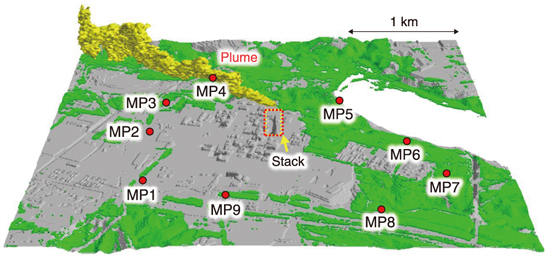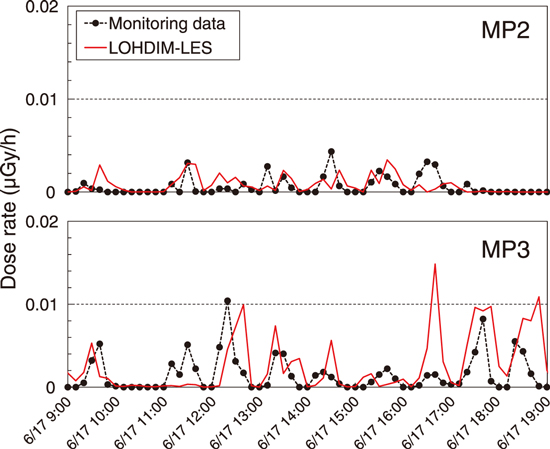
Fig.4-8 Instantaneous plume dispersion field at Rokkasho Reprocessing Plant at 10:40 JST June 17th, 2008

Fig.4-9 Time series of the air dose rate at the monitoring posts (MPs) during the period from 09:00 JST to 19:00 JST June 17th, 2008
We developed a local-scale high-resolution atmospheric dispersion and dose assessment system (LHADDAS) for the safety and consequence assessment of nuclear facilities and emergency response to nuclear accidents or deliberate releases of radioactive materials in built-up urban areas. The system was built in cooperation with the Center for Computational Science and e-Systems (CCSE). This system comprises three parts: (1) A component for the preprocessing of input files and a local-scale high-resolution atmospheric dispersion model using large-eddy simulation (LOHDIM-LES) for the main calculation*1, (2) a real-time urban dispersion simulation model based on a lattice Boltzmann method (CityLBM)*3, and (3) a simulation code powered by lattice dose-response functions (SIBYL) for the postprocessing of dose calculation*2.
We examined the performance of LHADDAS using two application cases from our previous studies. The first case involved a controlled tracer plume dispersion in the vicinity of an actual nuclear facility and building arrays. The second focused on tracer gas dispersion in an actual central urban district. In this article, we describe the first application case of the LOHDIM-LES simulation of the actual tracer plume dispersion of radionuclides released from the nuclear fuel reprocessing plant in Rokkasho, Japan, as an example. The simulation period was from 09:00–19:30 Japan Standard Time (JST) on June 17th, 2008. Fig.4-8 shows an instantaneous shot of the tracer plume released into the atmosphere from a stack at 10:40 JST on June 17th. Fig.4-9 shows a comparison of the LOHDIM-LES results with the monitoring post (MP) data. An intermittent increase in the air dose rates at MP2 was noted. These rates frequently showed higher peaks at MP3 than at MP2. This result indicated that the main part of the plume was transported over MP3. These time variation patterns at the different MPs were simulated well by LOHDIM-LES integrated with the SIBYL module. The model performance of LOHDIM-LES and CityLBM was also demonstrated using the data collected during urban field experiments for the second application case.
LHADDAS has broad functionalities and performs extremely well in simulating turbulent flows, plume dispersion, and dry deposition under realistic meteorological conditions. It can simulate real-time tracer dispersion using a locally mesh-refined lattice Boltzmann method. Moreover, it can estimate the air dose rates of radionuclides from air concentration and surface deposition considering the influence of individual buildings.
(Hiromasa Nakayama)
*1 Nakayama, H. et al., Development of Local-Scale High-Resolution Atmospheric Dispersion Model Using Large-Eddy Simulation Part 6: Introduction of Detailed Dose Calculation Method, Journal of Nuclear Science and Technology, vol.58, issue 9, 2021, p.949-969.
*2 Satoh, D., Nakayama, H. et al., Simulation Code for Estimating External Gamma-Ray Doses from a Radioactive Plume and Contaminated Ground Using a Local-Scale Atmospheric Dispersion Model, PLOS ONE, vol.16, no.1, 2021, e0245932, 26p.
*3 Onodera, N., Nakayama, H. et al., Real-Time Tracer Dispersion Simulations in Oklahoma City Using the Locally Mesh-Refined Lattice Boltzmann Method, Boundary-Layer Meteorology, vol.179, issue 2, 2021, p.187-208.